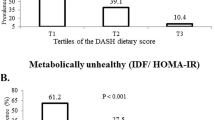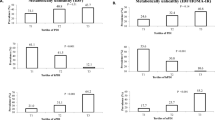Abstract
Objective:
The aim of this work was to develop an index that evaluates the degree of adherence to existing dietary and lifestyle guidelines for primary school-aged children (Healthy Lifestyle–Diet Index (HLD-Index)) and examine its relationship with selected nutrient intake and insulin resistance (IR).
Methods:
Ten components were used to develop the HLD-Index. Scores from 0 to 4 were assigned to all components. The HLD-Index total score ranged between 0 and 40. A sample of 729 schoolchildren from Greece aged 10–12 years (The Healthy Growth Study) was used to evaluate the validation of the proposed index.
Results:
The overall mean±standard deviation of the HLD-Index score was 20±4.4. Higher HLD-Index scores were associated with lower proportion of children having intakes lower than Estimated Average Requirements by Institute of Medicine. On the basis of the cutoff point of 3.16 for homeostasis model assessment of IR, 20.9% of participants were found to be insulin resistant. After adjusting for potential confounders, logistic regression showed that a 1 unit increase in the score is associated with almost 8% lower odds for being insulin resistant. The cutoff point analysis revealed that score equal to or lower than 21 best discriminates children with IR from those without IR. On the basis of this cutoff point, the sensitivity of the HLD-Index was 70% and the corresponding specificity was 47%.
Conclusions:
The proposed HLD-Index could be used by public health policy makers and other health-care professionals to identify subgroups in the population with poor diet–lifestyle habits who are at increased probability for IR.
This is a preview of subscription content, access via your institution
Access options
Subscribe to this journal
Receive 12 print issues and online access
$259.00 per year
only $21.58 per issue
Buy this article
- Purchase on Springer Link
- Instant access to full article PDF
Prices may be subject to local taxes which are calculated during checkout
Similar content being viewed by others
References
American Academy of Pediatrics (2001). Children, adolescents, and television. Pediatrics 107, 423–426.
Bach A, Serra-Majem L, Carrasco JL, Roman B, Ngo J, Bertomeu I et al. (2006). The use of indexes evaluating the adherence to the Mediterranean diet in epidemiological studies: a review. Public Health Nutr 9, 132–146.
Bremer AA, Auinger P, Byrd RS (2009). Relationship between insulin resistance-associated metabolic parameters and anthropometric measurements with sugar-sweetened beverage intake and physical activity levels in US adolescents: findings from the 1999–2004 National Health and Nutrition Examination Survey. Arch Pediatr Adolesc Med 163, 328–335.
Canete R, Gil-Campos M, Aguilera CM, Gil A (2007). Development of insulin resistance and its relation to diet in the obese child. Eur J Nutr 46, 181–187.
Devaney B, Ziegler P, Pac S, Karwe V, Barr SI (2004). Nutrient intakes of infants and toddlers. J Am Diet Assoc 104 (Suppl 1), s14–s21.
Feskanich D, Rockett HR, Colditz GA (2004). Modifying the healthy eating index to assess diet quality in children and adolescents. J Am Diet Assoc 104, 1375–1383.
Hampl JS, Taylor CA, Johnston CS (1999). Intakes of vitamin C, vegetables and fruits: which schoolchildren are at risk? J Am Coll Nutr 18, 582–590.
Hesketh K, Wake M, Waters E, Carlin J, Crawford D (2004). Stability of body mass index in Australian children: a prospective cohort study across the middle childhood years. Public Health Nutr 7, 303–309.
Hirschler V, Oestreicher K, Beccaria M, Hidalgo M, Maccallini G (2009). Inverse association between insulin resistance and frequency of milk consumption in low-income Argentinean school children. J Pediatr 154, 101–105.
Institute of Medicine (2000). Journal Title: Dietary Reference Intakes. Applications in Dietary Assessment. National Academy Press: Washington, DC.
Isganaitis E, Lustig RH (2005). Fast food, central nervous system insulin resistance, and obesity. Arterioscler Thromb Vasc Biol 25, 2451–2462.
Jacques PF, Tucker KL (2001). Are dietary patterns useful for understanding the role of diet in chronic disease? Am J Clin Nutr 73, 1–2.
Kelishadi R, Cook SR, Amra B, Adibi A (2009a). Factors associated with insulin resistance and non-alcoholic fatty liver disease among youths. Atherosclerosis 204, 538–543.
Kelishadi R, Mirghaffari N, Poursafa P, Gidding SS (2009b). Lifestyle and environmental factors associated with inflammation, oxidative stress and insulin resistance in children. Atherosclerosis 203, 311–319.
Kennedy A, Martinez K, Chuang CC, LaPoint K, McIntosh M (2009). Saturated fatty acid-mediated inflammation and insulin resistance in adipose tissue: mechanisms of action and implications. J Nutr 139, 1–4.
Kennedy ET, Ohls J, Carlson S, Fleming K (1995). The healthy eating index: design and applications. J Am Diet Assoc 95, 1103–1108.
Keskin M, Kurtoglu S, Kendirci M, Atabek ME, Yazici C (2005). Homeostasis model assessment is more reliable than the fasting glucose/insulin ratio and quantitative insulin sensitivity check index for assessing insulin resistance among obese children and adolescents. Pediatrics 115, e500–e503.
Kosti RI, Panagiotakos DB, Mariolis A, Zampelas A, Athanasopoulos P, Tountas Y (2009). The diet–lifestyle index evaluating the quality of eating and lifestyle behaviours in relation to the prevalence of overweight/obesity in adolescents. Int J Food Sci Nutr 60 (Suppl 3), 34–47.
Kranz S, Siega-Riz AM, Herring AH (2004). Changes in diet quality of American preschoolers between 1977 and 1998. Am J Public Health 94, 1525–1530.
Lara-Castro C, Garvey WT (2004). Diet, insulin resistance, and obesity: zoning in on data for Atkins dieters living in South Beach. J Clin Endocrinol Metab 89, 4197–4205.
Lazarou C, Panagiotakos DB, Matalas AL (2009). Foods E-KINDEX: a dietary index associated with reduced blood pressure levels among young children: the CYKIDS study. J Am Diet Assoc 109, 1070–1075.
Ma G, Hall WJ (1993). Confidence bands for receiver operating characteristic curves. Med Decis Making 13, 191–197.
Magarey AM, Daniels LA, Boulton TJ (2001). Prevalence of overweight and obesity in Australian children and adolescents: reassessment of 1985 and 1995 data against new standard international definitions. Med J Aust 174, 561–564.
Manios Y, Kourlaba G, Kondaki K, Grammatikaki E, Birbilis M, Oikonomou E et al. (2009). Diet quality of preschoolers in Greece based on the healthy eating index: the GENESIS study. J Am Diet Assoc 109, 616–623.
Manios Y, Kafatos A, Markakis G (1998). Physical activity in 6-year-old children: validation of two proxy reports. Pediatr Exerc Sci 10, 176–188.
Matthews DR, Hosker JP, Rudenski AS, Naylor BA, Treacher DF, Turner RC (1985). Homeostasis model assessment: insulin resistance and beta-cell function from fasting plasma glucose and insulin concentrations in man. Diabetologia 28, 412–419.
Moschonis G, Tanagra S, Vandorou A, Kyriakou AE, Dede V, Siatitsa PE et al. (2010). Social, economic and demographic correlates of overweight and obesity in primary schoolchildren. Preliminary data from the Healthy Growth Study. Public Health Nutr (in press).
Muller MJ, Koertzinger I, Mast M, Langnase K, Grund A (1999). Physical activity and diet in 5 to 7 years old children. Public Health Nutr 2, 443–444.
Muntner P, He J, Cutler JA, Wildman RP, Whelton PK (2004). Trends in blood pressure among children and adolescents. JAMA 291, 2107–2113.
Nicklas TA, Farris RP, Johnson CC, Webber LS, Berenson GS (1990). Food Sources of Nutrients: A Tool for Dietary Management and Health. The Bogalusa Heart Study. Tulane Center for Cardiovascular Health: New Orleans, LA. pp 1973–1983.
Nicklas TA, Yang SJ, Baranowski T, Zakeri I, Berenson G (2003). Eating patterns and obesity in children. The Bogalusa Heart Study. Am J Prev Med 25, 9–16.
Panagiotakos DB, Pitsavos C, Arvaniti F, Stefanadis C (2007). Adherence to the Mediterranean food pattern predicts the prevalence of hypertension, hypercholesterolemia, diabetes and obesity, among healthy adults; the accuracy of the MedDietScore. Prev Med 44, 335–340.
Pereira MA, Jacobs Jr DR, Van Horn L, Slattery ML, Kartashov AI, Ludwig DS (2002). Dairy consumption, obesity, and the insulin resistance syndrome in young adults: the CARDIA Study. JAMA 287, 2081–2089.
Serra-Majem L, Ribas L, Ngo J, Ortega RM, Garcia A, Perez-Rodrigo C et al. (2004). Food, youth and the Mediterranean diet in Spain. Development of KIDMED, Mediterranean Diet Quality Index in children and adolescents. Public Health Nutr 7, 931–935.
Slinger JD, van Breda E, Keizer H, Rump P, Hornstra G, Kuipers H (2008). Insulin resistance, physical fitness, body composition and leptin concentration in 7–8 year-old children. J Sci Med Sport 11, 132–138.
Strasburger VC (2006). Children, adolescents, and advertising. Pediatrics 118, 2563–2569.
Szamosi A, Czinner A, Szamosi T, Sallai A, Hatunic M, Berla Z et al. (2008). Effect of diet and physical exercise treatment on insulin resistance syndrome of schoolchildren. J Am Coll Nutr 27, 177–183.
Tanner JM, Whitehouse RH (1962). Standards for subcutaneous fat in British children. Percentiles for thickness of skinfolds over triceps and below scapula. BMJ 1, 446–450.
Trichopoulou A (2004). Composition Tables of Foods and Greek Dishes. School of Medicine, Department of Hygiene and Epidemiology: Athens, Greece.
University of Crete (1991). Food Composition Tables. nutrition.med.uoc.gr/GreekTables.
Waijers PM, Feskens EJ, Ocke MC (2007). A critical review of predefined diet quality scores. Br J Nutr 97, 219–231.
Acknowledgements
We would like to thank Sofia Tanagra, Anthi Naoumi, Maria Kantilafti, Aliki-Eleni Farmaki, Odysseas Androutsos, Maria Lymperi, Nora Karatsikaki, Konstantina Yfanti, Konstantinos Koutsikas, Louisa Damianidi, Despoina-Rodopi Gkakni, Sofia Micheli, Maria Nikolidaki, Ariadni Lidoriki, Vasiliki Iatridi, Maria Spyridonos, Panagiotis Kliasios, Konstantina Maragkopoulou, Fanouria Chlouveraki, Eleni Zompoulia Papadopoulou, Elpida Voutsadaki, Eirini Tsikalaki, Kelaidi Michailidou and Sofia Komninou for their contribution to the completion of the study.
Author information
Authors and Affiliations
Corresponding author
Ethics declarations
Competing interests
The authors declare no conflict of interest.
Rights and permissions
About this article
Cite this article
Manios, Y., Kourlaba, G., Grammatikaki, E. et al. Development of a lifestyle–diet quality index for primary schoolchildren and its relation to insulin resistance: the Healthy Lifestyle–Diet Index. Eur J Clin Nutr 64, 1399–1406 (2010). https://doi.org/10.1038/ejcn.2010.172
Received:
Revised:
Accepted:
Published:
Issue Date:
DOI: https://doi.org/10.1038/ejcn.2010.172
Keywords
This article is cited by
-
Diet quality indices and their associations with health-related outcomes in children and adolescents: an updated systematic review
Nutrition Journal (2020)
-
An obesity-preventive lifestyle score is negatively associated with pediatric asthma
European Journal of Nutrition (2018)



